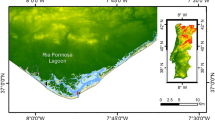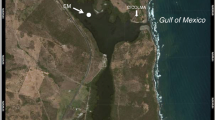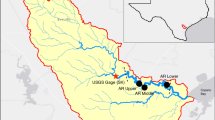Abstract
Water quality management strategies focus primarily on reducing nutrient loading in estuaries to limit total chlorophyll a (chl a) to less than 40 μg l−1. However, potential alterations in phytoplankton community composition and subsequent ecological implications below this limit are not generally considered. The effect of moderate loadings of nitrate (N) and phosphate (P) on nutrient-limited phytoplankton composition and cell size was investigated using multiple bioassays from 2014 to 2016 to evaluate phytoplankton community shifts below the 40 μg l−1 threshold. Water collected from North Inlet Estuary, SC, was spiked with 20 μmol l−1 N and of 10 μmol l−1 P and incubated for 2 days. The proportion of diatoms, cryptophytes, cyanobacteria, prasinophytes, and chlorophytes was calculated for each treatment (i.e., control and NP addition) and for two size fractions (i.e., < 20 μm and whole water). Phytoplankton biomass increases were below the 40 μg chl a l−1 threshold and resulted in a variable shift in phytoplankton group abundances, likely due to the initial community composition. Nutrient additions enhanced the biomass of the fraction smaller than 20 μm and the proportion of diatoms at the expense of cyanobacteria and cryptophytes. Shifts in community composition could have potential cascading impacts on higher trophic levels in the estuary. These results highlight the importance of characterizing and monitoring eutrophication using abundances of algal groups in addition to total biomass as ecologically relevant alterations may occur at low levels of eutrophication.




Similar content being viewed by others
References
Albright, L.C., C. Yang, and S. Johnson. 1993. Sub-lethal concentrations of the harmful diatoms Chaetoceros concavicornis and C. convolutes increase mortality rates of penned Pacific salmon. Aquaculture 117: 215–225.
Allen, D.M., W.B. Allen, R.F. Feller, and J.S. Plunket. 2014. Site profile of the North Inlet–Winyah Bay National Estuarine Research Reserve. Georgetown: North Inlet–Winyah Bay National Estuarine Research Reserve.
Anderson, D.M., P.M. Glibert, and J.M. Burkholder. 2002. Harmful algal blooms and eutrophication: Nutrient sources, composition, and consequences. Estuaries 25 (4b): 704–726.
Baum, J.K., and B. Worm. 2009. Cascading top-down effects of changing oceanic predator abundances. Journal of Animal Ecology 78: 699–714.
Bell, D.W., S. Denham, E.M. Smith, and C.R. Benitez-Nelson. 2018. Temporal variability in ecological stoichiometry and material exchange in a tidally dominated estuary (North Inlet, South Carolina) and the impact on community nutrient status. Esuaries and Coasts. https://doi.org/10.1007/s12237-018-0430-7.
Beutel, M.W., R. Duvil, F.J. Cubas, D.A. Matthews, F.M. Wilhelm, T.J. Grizzard, D. Austin, A.J. Horne, and S. Gebremariam. 2016. A review of managed nitrate addition to enhance surface water quality. Critical Reviews in Environmental Science and Technology 46 (7): 673–700.
Bodeanu, N., and G.R. Uta. 1998. Development of the planktonic algae in the Romanian Black Sea sector in 1981–1996. In Harmful algae, ed. B. Reguera, J. Blanco, M.L. Fernandez, and T. Wyatt, 188–191. Paris: Xunta de Galicia and Intergovernmental Oceanographic Commission of United Nations Educational, Scientific and Cultural Organization.
Bowman, M.F., P.A. Chambers, and D.W. Schindler. 2007. Constraints on benthic algal response to nutrient addition in oligotrophic mountain rivers. River Research and Applications 23: 858–876.
Boyd, P.W., R. Strzepek, F.X. Fu, and D.A. Hutchins. 2010. Environmental control of open ocean phytoplankton groups: Now and in the future. Limnology and Oceanography 55: 1353–1376.
Bužančić, M., Z.N. Gladan, I. Marasović, G. Kušpilić, and B. Grbec. 2016. Eutrophication influence on phytoplankton community composition in three bays on the eastern Adriatic coast. Oceanologia 58: 302–316.
Buzzelli, C., O. Akman, T. Buck, E. Koepfler, J. Morris, and A. Lewitus. 2004. Relationships among water-quality parameters from the North Inlet—Winyah Bay National Estuarine Research Reserve, South Carolina. Journal of Coastal Research SI 45: 59–74.
Caron, D.A., E.L. Lim, R.W. Sanders, M.R. Dennett, and U.G. Berninger. 2000. Responses of bacterioplankton and phytoplankton to organic carbon and inorganic nutrient additions in contrasting oceanic ecosystems. Aquatic Microbial Ecology 22 (2): 175–184.
Caron, D.A., A.G. Gellene, J. Smith, E.L. Seubert, V. Campbell, G.S. Sukhatme, B. Seegers, B.H. Jones, A.A.Y. Lie, R. Terrado, M.D.A. Howard, R.M. Kudela, K. Hayashi, J. Ryan, J. Birch, E. Demir-Hilton, K. Yamahara, C. Scholin, M. Mengel, and G. Robertson. 2017. Response of phytoplankton and bacterial biomass during a waste water effluent diversion into nearshore coastal waters. Estuarine, Coastal and Shelf Science 186: 223–236.
Carstensen, J., R. Klais, and J.E. Cloern. 2015. Phytoplankton blooms in estuarine and coastal waters: Seasonal patterns and key species. Estuarine, Coastal and Shelf Science 162: 98–109.
Chislock, M.F., E. Doster, R.A. Zitomer, and A.E. Wilson. 2013. Eutrophication: Causes, consequences, and controls in aquatic ecosystems. Nature Education Knowledge 4 (4): 10.
Clark, D.R., K.J. Flynn, and N.J.P. Owens. 2002. The large capacity for dark nitrate-assimilation in diatoms may overcome nitrate limitation of growth. New Phytologist 155: 101–108.
Clarke, A., M.P. Meredith, M.I. Wallace, M.A. Brandon, and D.N. Thomas. 2008. Seasonal and interannual variability in temperature, chlorophyll and macronutrients in northern Marguerite Bay, Antarctica. Deep-Sea Research. II 55: 1988–2006.
Clement, A. and G. Lembeye. 1993. Phytoplankton monitoring program in the fish farming region of South Chile. In T.J. Smayda and Y. Shimizu (Eds.). Toxic phytoplankton blooms in the sea. p. 223–228.
Dame, R.F., J.D. Spurrier, T.M. Williams, B. Kjerfve, R.G. Zingmark, T.G. Wolaver, T.H. Chrzanowski, H.N. McKellar, and F.J. Vernberg. 1991. Annual material processing by a salt-marsh estuarine-basin in South Carolina, USA. Marine Ecology Progress Series 72 (1–2): 153–166.
Domingues, R.B., T.A. Anselmo, A.B. Barbosa, U. Sommer, and H.M. Galvão. 2010. Nutrient limitation of phytoplankton growth in the freshwater tidal zone of a turbid, Mediterranean estuary. Estuarine Shelf and Coastal Science 91 (2): 282–297.
Domingues, R.B., A.B. Barbosa, U. Sommer, and H.M. Galvão. 2011. Ammonium, nitrate and phytoplankton interactions in a freshwater tidal estuarine zone: Potential effects of cultural eutrophication. Aquatic Sciences 73: 331–343.
Ferreira, J.G., J.H. Andersen, A. Borja, S.B. Bricker, J. Camp, M. Cardoso da Silva, E. Garcés, A.S. Heiskanen, C. Humborg, L. Ignatiades, C. Lancelot, A. Menesguen, P. Tett, N. Hoepffner, and U. Claussen. 2011. Overview of eutrophication indicators to assess the environmental status within the European Marine Strategy Framework Directive. Estuarine, Coastal and Shelf Science 93: 117–131.
Fu, F.X., A.O. Tatters, and D.A. Hutchins. 2012. Global change and the future of harmful algal blooms in the ocean. Marine Ecology Progress Series 470: 207–233.
Gao, K., E.W. Helbling, D.P. Häder, and D.A. Hutchins. 2012. Responses of marine primary producers to interactions between ocean acidification, solar radiation, and warming. Marine Ecology Progress Series 470: 167–189.
Glibert, P. 2017. Eutrophication, harmful algae and biodiversity—Challenging paradigms in a world of complex nutrient changes. Marine Pollution Bulletin 124: 591–606.
Glibert, P.M., F.P. Wilkerson, R.C. Dugdale, J.A. Raven, C. Dupont, P.R. Leavitt, A.E. Parker, J.M. Burkholder, and T.M. Kana. 2016. Pluses and minuses of ammonium and nitrate uptake and assimilation by phytoplankton and implications for productivity and community composition, with emphasis on nitrogen-enriched conditions. Limnology and Oceanography 61: 165–197.
Granéli, E., M. Weberg, and P.S. Salomon. 2008. Harmful algal blooms of allelopathic microalgal species: The role of eutrophication. Harmful Algae 8: 94–102.
Grasshoff, K.K., K. Kremling, and M. Ehrhardt. 1999. Methods of seawater analysis. Weinheim: Wiley VCH Verlag GmbH Publishers.
Hannach, G., and A.C. Sigleo. 1998. Photoinduction of UV-absorbing compounds in six species of marine phytoplankton. Marine Ecology Progress Series 174: 207–222.
Heisler, J., P.M. Glibert, J.M. Burkholder, D.M. Anderson, W. Cochlan, W.C. Dennison, Q. Dortch, C.J. Gobler, C.A. Heil, E. Humphries, A. Lewitus, R. Magnien, H.G. Marshall, K. Sellner, D.A. Stockwell, D.K. Stoecker, and M. Suddleson. 2008. Eutrophication and harmful algal blooms: A scientific consensus. Harmful Algae 8: 3–13.
Higgins, H.W., S.W. Wright, and L. Schlüter. 2011. Quantitative interpretation of chemotaxonomic pigment data. In Phytoplankton pigments—Characterization, chemotaxonomy and applications in oceanography, Eds. Roy, S., C., Llewellyn, E.S., Egeland, G., Johnsen. Cambridge University Press, Cambridge, United Kingdom and New York, NY, USA p 257–313.
IPCC. 2013. Climate Change 2013: the physical science basis. Contribution of Working Group I to the Fifth Assessment Report of the Intergovernmental Panel on Climate Change, Eds: Stocker, T.F., D. Qin, G.-K. Plattner, M. Tignor, S.K. Allen, J. Boschung, A. Nauels, Y. Xia, V. Bex, and P.M. Midgley. Cambridge University Press, Cambridge, United Kingdom and New York, NY, USA. 1535 pp.
Johnson, K.S., and R.L. Petty. 1983. Determination of nitrate and nitrite in seawater by flow injection analysis. Limnology and Oceanography 28: 1260–1266.
Kamp, A., S. Høgslund, N. Risgaard-Petersen, and P. Stief. 2015. Nitrate storage and dissimilatory nitrate reduction by eukaryotic microbes. Frontiers in Microbiology 6: 1492–1507.
Keppler, C.J., D.C. Bergquist, L.M. Brock, J. Felber, and D.I. Greenfield. 2015. A spatial assessment of baseline nutrient and water quality values in the Ashepoo–Combahee–Edisto (ACE) Basin, South Carolina, USA. Marine Pollution Bulletin 99: 332–337.
Kiorboe, T., and F. Mohlenberg. 1981. Particle selection in suspension-feeding bivalves. Marine Ecology Progress Series 5: 291–296.
Lawrenz, E., E.M. Smith, and T.L. Richardson. 2013. Spectral irradiance, phytoplankton community composition and primary productivity in a salt marsh estuary, North Inlet, South Carolina, USA. Estuaries and Coasts 36: 347–364.
Lelong, A., H. Hégaret, P. Soudant, and S.S. Bates. 2012. Pseudo-nitzschia (Bacillariophyceae) species, domoic acid and amnesic shellfish poisoning: Revisiting previous paradigms. Phycologia 51 (2): 168–216.
Lewitus, A.J., E.T. Koepfler, and J.T. Morris. 1998. Seasonal variation in the regulation of phytoplankton by nitrogen and grazing in a salt-marsh estuary. Limnology and Oceanography 43: 636–646.
Lewitus, A.J., L.B. Schmidt, L.J. Mason, J.W. Kempton, S.B. Wilde, J.L. Wolny, B.J. Williams, K.C. Hayes, S.N. Hymel, C.J. Keppler, and A.H. Ringwood. 2003. Harmful algal blooms in South Carolina residential and golf course ponds. Population and Environment 24 (5): 387–413.
Lewitus, A.J., D.L. White, R.G. Tymowski, M.E. Geesey, S.N. Hymel, and P.A. Noble. 2005. Adapting the CHEMTAX method for assessing phytoplankton taxonomic composition in Southeastern U.S. estuaries. Coastal and Estuarine Research Federation 28: 160–172.
Lewitus, A.J., L.M. Brock, M.K. Burke, K.A. DeMattio, and S.B. Wilde. 2008. Lagoonal stormwater detention ponds as promoters of harmful algal blooms and eutrophication along the South Carolina coast. Harmful Algae 8 (1): 60–65.
Li, X., Z. Yu, X. Song, X. Cao, and Y. Yuan. 2011. The seasonal characteristics of dissolved oxygen distribution and hypoxia in the Changjiang estuary. Journal of Coastal Research 27 (6A): 52–62.
Lim, J.H., and C.W. Lee. 2017. Effects of eutrophication on diatom abundance, biovolume and diversity in tropical coastal waters. Environmental Monitoring and Assessment 189: 432–442.
Litchman, E., C.A. Klausmeier, O.M. Schofield, and P.G. Falkowski. 2007. The role of functional traits and trade-offs in structuring phytoplankton communities: Scaling from cellular to ecosystem level. Ecology Letters 10: 1170–1181.
Lomas, M.W., and P.M. Glibert. 2000. Comparisons of nitrate uptake, storage and reduction in marine diatoms and flagellates. Journal of Phycology 36: 903–913.
Marañón, E. 2015. Cell size as a key determinant of phytoplankton metabolism and community structure. Annual Review of Marine Science 7: 241–264.
McQueen, D.J., and J. Post. 1988. Cascading trophic interactions: Uncoupling at the zooplankton-phytoplankton link. Hydrobiologia 159: 277–296.
Morris, L., and G. Nicholson. 2015. Can moderate increases in nutrient loads cause ecological effects in rivers already impacted by nutrients? Hydrobiologia 749: 213–229.
Najdek, M., M. Blažina, T. Djakovac, and R. Kraus. 2005. The role of the diatom Cylindrotheca closterium in a mucilage event in the northern Adriatic Sea: Coupling with high salinity water intrusions. Journal of Plankton Research 27 (9): 851–862.
Nejstgaard, J.C., B.H. Hygum, L.-J. Naustvoll, and U. Bamstedt. 2001. Zooplankton growth, diet, and reproductive success compared in simultaneous diatom- and flagellate-microzooplankton-dominated plankton blooms. Marine Ecology Progress Series 221: 77–91.
Örnólfsdóttir, E.B., S.E. Lumsden, and J.L. Pinckney. 2004. Phytoplankton community growth-rate response to nutrient pulses in a shallow turbid estuary, Galveston Bay, Texas. Journal of Plankton Research 26 (3): 325–339.
Paerl, H.W., L.M. Valdes, J.L. Pinckney, M.F. Piehler, J. Dyble, and P.H. Moisander. 2003. Phytoplankton photopigments as indicators of estuarine and coastal eutrophication. BioScience 53 (10): 953–964.
Pinckney, J.L., D.F. Millie, K.E. Howe, H.W. Paerl, and J.P. Hurley. 1996. Flow scintillation counting of 14C-labeled microalgal photosynthetic pigments. Journal of Plankton Research 18: 1867–1910.
Pinckney, J.L., H.W. Paerl, P. Tester, and T.L. Richardson. 2001. The role of nutrient loading and eutrophication in estuarine ecology. Environmental Health Perspectives 109: 699–706.
Rabalais, N.N., R.E. Turner, R.J. Díaz, and D. Justić. 2009. Global change and eutrophication of coastal waters. ICES Journal of Marine Science 66: 1528–1537.
Raven, J.A., B. Wollenweber, and L.L. Handley. 1992. A comparison of ammonium and nitrate as nitrogen sources for photolithotrophs. New Phytologist 121: 19–32.
Reed, M.L., J.L. Pinckney, C.J. Keppler, L.M. Brock, S.B. Hogan, and D.I. Greenfield. 2016. The influence of nitrogen and phosphorus on phytoplankton growth and assemblage composition in four coastal, southeastern USA systems. Estuarine, Coastal and Shelf Science 177: 71–82.
Sarthou, G., K.R. Timmermans, S. Blain, and P. Tréguer. 2005. Growth physiology and fate of diatoms in the ocean: A review. Journal of Sea Research 53: 25–42.
Scavia, D., and S.B. Bricker. 2006. Coastal eutrophication assessment in the United States. Biogeochemistry 79: 187–208.
Smayda, T.J., 2006. Harmful algal bloom communities in Scottish coastal waters: Relationship to fish farming and regional comparisons—A review: Paper 2006/3. Scottish Executive www.scotland.gov.uk/Publications/2006/02/03095327/16.
Smith, V.H., and D.W. Schindler. 2008. Eutrophication science: Where do we go from here? Trends Ecology and Evolution 24 (4): 201–207.
South Carolina Sea Grant Consortium. 1992. Characterization of the physical, chemical and biological conditions and trends in three South Carolina estuaries: 1970–1985. South Carolina Sea Grant Consortium: Charleston.
Treasurer, J.W., F. Hannah and D. Cox. 2003. Impact of a phytoplankton bloom on mortalities and feeding response of farmed Atlantic salmon, Salmo salar, in west Scotland. Aquaculture 218(1):103–113.
Troup, M.L., D.B. Fribance, S.M. Libes, R. Gurka, and E.E. Hackett. 2017. Physical conditions of coastal hypoxia in the open embayment of Long Bay, South Carolina: 2006–2014. Estuaries and Coasts 40: 1576–1591.
Van Meerssche, E., D.I. Greenfield, and J.L. Pinckney. 2018. Coastal eutrophication and freshening: Impacts on Pseudo-nitzschia abundance and domoic acid allelopathy. Estuarine, Coastal and Shelf Science 209: 70–79.
Vrzel, J., B. Vuković-Gačić, S. Kolarević, Z. Gačić, M. Kračun-Kolarević, J. Kostić, M. Aborgiba, A. Farnleitner, G. Reischer, R. Linke, M. Paunović, and N. Ogrinc. 2016. Determination of the sources of nitrate and the microbiological sources of pollution in the Sava River Basin. Science of the Total Environment 573: 1460–1471.
Wells, M.L., V.L. Trainer, T.J. Smayda, B.S.O. Karlson, C.G. Trick, R.M. Kudela, A. Ishikawa, S. Bernard, A. Wulff, D.M. Anderson, and W.P. Cochlan. 2015. Harmful algal blooms and climate change: Learning from the past and present to forecast the future. Harmful Algae 49: 68–93.
Wetz, M.S., K.C. Hayes, A.J. Lewitus, J.L. Wolny, and D.L. White. 2006. Variability in phytoplankton pigment biomass and taxonomic composition over tidal cycles in a salt marsh estuary. Marine Ecology Progress Series 320: 109–120.
White, D.L., D.E. Porter, and A.J. Lewitus. 2004. Spatial and temporal analyses of water quality and phytoplankton biomass in an urbanized versus a relatively pristine salt marsh estuary. Journal of Experimental Marine Biology and Ecology 298: 255–273.
Wilkerson, F.P., R.C. Dugdale, V.E. Hogue, and A. Marchi. 2006. Phytoplankton blooms and nitrogen productivity in San Francisco Bay. Estuaries and Coasts 29: 401–416.
Zhao, Y., and A. Quigg. 2014. Nutrient limitation in Northern Gulf of Mexico (NGOM): Phytoplankton communities and photosynthesis respond to nutrient pulse. PLoS One 9 (2): e88732.
Zingone, A., and H.O. Enevoldsen. 2000. The diversity of harmful algal blooms: A challenge for science and management. Ocean and Coastal Management 43 (8–9): 725–748.
Acknowledgments
We thank C. Doll and J.P. Everhart for their assistance with photopigment and nutrient analyses. We also thank Dr. Dianne Greenfield and the anonymous reviewers for their insightful comments and suggestions. This is publication 1867 from the Belle W. Baruch Institute for Marine and Coastal Sciences.
Funding
This work was supported by the F. John Vernberg Fellowship, the Slocum-Lunz Foundation, and the SPARC fellowship received from the University of South Carolina and from the Baruch Institute.
Author information
Authors and Affiliations
Corresponding author
Ethics declarations
Conflict of Interest
The authors declare that they have no conflict of interest.
Additional information
Communicated by Wim J. Kimmerer
Rights and permissions
About this article
Cite this article
Van Meerssche, E., Pinckney, J.L. Nutrient Loading Impacts on Estuarine Phytoplankton Size and Community Composition: Community-Based Indicators of Eutrophication. Estuaries and Coasts 42, 504–512 (2019). https://doi.org/10.1007/s12237-018-0470-z
Received:
Revised:
Accepted:
Published:
Issue Date:
DOI: https://doi.org/10.1007/s12237-018-0470-z




